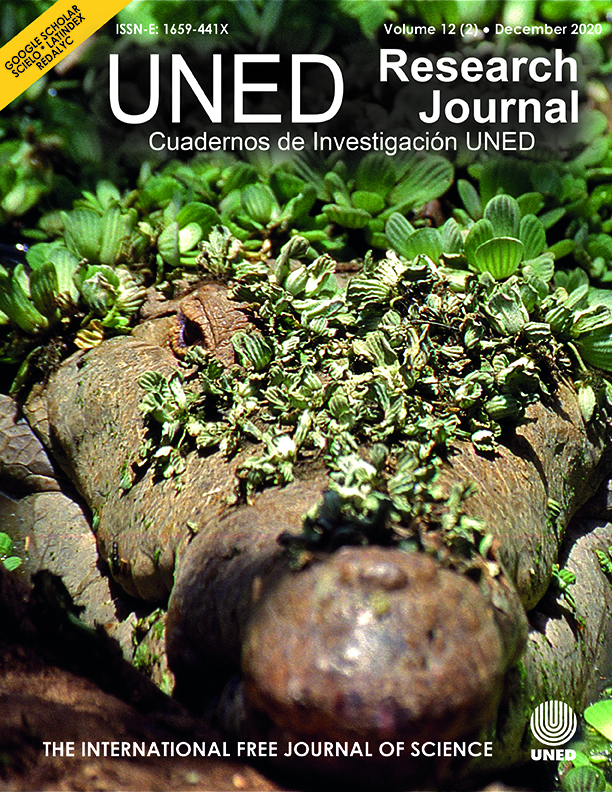Individual identification of Crocodylus intermedius (Orinoco crocodile) using tail spot patterns
DOI:
https://doi.org/10.22458/urj.v12i2.3140Keywords:
Conservation, Management, Individual identification, Crocodylus intermedius, Mark-recaptureAbstract
Introduction: The Conservation Action Plan of the Orinoco crocodile (Crocodylus intermedius) includes in its activities the release of captive-bred specimens back into the wild. By monitoring these specimens in their natural habitat their adaptability is assessed. However, an accurate identification system is necessary to recognize the individuals when they are recaptured. Objetive: Determinate if Swanepoel or Boucher et al. for crocodile identification for the Orinoco crocodile is useful. Methods: A total of 543 Orinoco crocodiles were photographed and each photo was vectorized by drawing dark spots greater than 25% for each scute, in the first 10 lines of double caudal scales of the tail on the right side. Two system codes were evaluated, one is a numeric code described by Swanepoel and the other is an additive code described by Boucher et al. Results: A total of 464 Swanepoel codes and 537 Boucher et al. codes based on the dark spot pattern of the scales on the right side of the tails were generated for the 543 specimens. Both methods yielded high code values, however, the one developed by Boucher et al., with a 98.90% differentiation of the analyzed specimens, worked better. Conclusion: The study confirms that using the method of spots in the tail of crocodiles is an effective tool for identifying individual crocodiles.
References
Boucher, M., M. Tellez and J. T. Anderson. (2017). A tail of two crocs: coding tail-spot patterns of individual identification of American (Crocodylus acutus) and Morelet’s (Crocodylus moreletii) crocodiles. Mesoamerican Herpetology 4(4):760-772.
Brazaitis, P. (1973). Identification of living crocodilians. Zoologica 58(1-4):58-102.
GECV. (2007). Estrategia nacional para la conservación del caimán del Orinoco en Venezuela y su Plan de Acción. En: III Taller para la conservación del caimán del Orinoco. Biollania edición especial N8: 77-86.
Cites. (1995). Identification guide-crocodilians. 1995. Environment Canada, Otawa and CITES Secretariat, Geneva.
Forero, M., J. Lozano & S. Balaguera-Reyna. (2019). Individual identification automation in Crocodilians throught imagery processing: American crocodile as a study case. SPIEDigital Library org/conference proceeding of spie.
Garcia-Grajales, J., A. Buenrostro & P. R. Tellez-Rodriguez. (2009). Variación de patrón de escutelación nucal del cocodrilo americano (Crocodylus acutus Cuvier 1807) en La Ventanilla, Oaxaca, México. Acta Zoológica Mexicana (n. s.), 25(2): 375-382.
Garrick, L. D. (1982). Variation in postoccipital and nuchal scale patterns of American crocodiles (Crocodylus acutus). Am. Zool. 22(4):906.
Platt, S., J. Thorbjarnarson & T. Rainwater. (2012). Scalation of the American crocodile, Crocodylus acutus (Crocodylidae, Crocodylia), from the coastal zone of northern Belize. Caribbean Journal of Science. 46(2-3):332-338.
Seijas, A. E. (2002). Scale patterns of American crocodile (Crocodylus acutus) from several Venezuelan localities. Rev. Unell. Cien. Tec. 20:188-134.
Swanepoel, D. G. J. (1996). Identification of the Nile crocodile Crocodylus niloticus by the use of natural tail marks. Koedoe. 39/1:113-115.
Velasco, A. (2003). Plan de acción para la conservación del caimán del Orinoco (Crocodylus intermedius). Oficina Nacional de la Diversidad Biológica, Ministerio del Ambiente y de los Recursos Naturales. Mimografiado. 14 pp.
Published
How to Cite
Issue
Section
License
Note: This abstract contains an incorrect copyright due to technical issues. Authors who publish with this journal agree to the following terms: Authors retain copyright and grant the journal right of first publication with the work simultaneously licensed under a Creative Commons Attribution License that allows others to share the work with an acknowledgement of the work's authorship and initial publication in this journal
All journal contents are freely available through a CC BY 4.0 license.
CC BY 4.0 is a Creative Commons: you can copy, modify, distribute, and perform, even for commercial reasons, without asking permission, if you give appropriate credit.
Contents can be reproduced if the source and copyright are acknowledged according to the Open Access license CC BY 4.0. Self-storage in preprint servers and repositories is allowed for all versions. We encourage authors to publish raw data and data logs in public repositories and to include the links with all drafts so that reviewers and readers can consult them at any time.
The journal is financed by public funds via Universidad Estatal a Distancia and editorial independence and ethical compliance are guaranteed by the Board of Editors, UNED. We do not publish paid ads or receive funds from companies.
